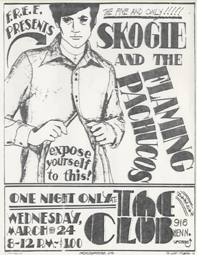Difference between revisions of "F.R.E.E."
| Line 13: | Line 13: | ||
|} | |} | ||
| − | The young organization served as a student group and as an outreach program for the Twin Cities. FREE sponsored public speakers who addressed church audiences—at times to “quiet, questions [and] doubts” —at the same time participants organized dances with “free coffee and lots of dancing.” | + | The young organization served as a student group and as an outreach program for the Twin Cities. FREE sponsored public speakers who addressed church audiences—at times to “quiet, questions [and] doubts”<small>(2)</small> —at the same time participants organized dances with “free coffee and lots of dancing.”<small>(3)</small> |
| − | Mainstream Minnesota received FREE with little fanfare or outrage; the organization was small (dances usually attracted about 100 people) and its queer members quietly spent much of their time establishing the foundations of Gay Liberation in Minnesota. Their “constitution” became a prototype for the bylaws of Gay House and other organizations, and the group’s correspondence with officials at the University of Minnesota set up a standard that remains to this day. Members even visited with the Minneapolis Police (at the latter’s request) to train officers on the treatment of gay and lesbian issues in law enforcement. | + | Mainstream Minnesota received FREE with little fanfare or outrage; the organization was small (dances usually attracted about 100 people)<small>(4)</small> and its queer members quietly spent much of their time establishing the foundations of Gay Liberation in Minnesota. Their “constitution” became a prototype for the bylaws of Gay House and other organizations, and the group’s correspondence with officials at the University of Minnesota set up a standard that remains to this day. Members even visited with the Minneapolis Police (at the latter’s request) to train officers on the treatment of gay and lesbian issues in law enforcement. |
| Line 24: | Line 24: | ||
---- | ---- | ||
<small>(1)</small>Holdgrafer, George. "Free Before Stonewall: Twin Cities Gay Organization Launched Six Weeks Prior to Pivotal New York Event." Lavender Magazine, Issue 366. | <small>(1)</small>Holdgrafer, George. "Free Before Stonewall: Twin Cities Gay Organization Launched Six Weeks Prior to Pivotal New York Event." Lavender Magazine, Issue 366. | ||
| + | |||
| + | <small>(2)</small>Queer Student Cultural Center Collection, Box 1. Jean-Nickolaus Tretter Collection in GLBT Studies, University of Minnesota Libraries. | ||
| + | |||
| + | <small>(3)</small>Baker, Jack. "FREE News." Minnesota: 12/18-1/9, 1970. Page 1. | ||
| + | |||
| + | <small>(4)</small>Baker, Jack. "FREE News." Minnesota: 11/24/1969. Page 1. | ||
| + | |||
This page is under construction. -SVC | This page is under construction. -SVC | ||
Part of [[Minneapolis/St. Paul, MN: 100 Queer Places in Minnesota History, (1860-1969), (1969-2010)]] | Part of [[Minneapolis/St. Paul, MN: 100 Queer Places in Minnesota History, (1860-1969), (1969-2010)]] | ||
Revision as of 12:50, 26 February 2010
(Fight Repression of Erotic Expression) Coffee Shop Extempore: 2200 Riverside Avenue, Minneapolis. Later the basement of Coffman Memorial Union at the University of Minnesota
The young organization served as a student group and as an outreach program for the Twin Cities. FREE sponsored public speakers who addressed church audiences—at times to “quiet, questions [and] doubts”(2) —at the same time participants organized dances with “free coffee and lots of dancing.”(3)
Mainstream Minnesota received FREE with little fanfare or outrage; the organization was small (dances usually attracted about 100 people)(4) and its queer members quietly spent much of their time establishing the foundations of Gay Liberation in Minnesota. Their “constitution” became a prototype for the bylaws of Gay House and other organizations, and the group’s correspondence with officials at the University of Minnesota set up a standard that remains to this day. Members even visited with the Minneapolis Police (at the latter’s request) to train officers on the treatment of gay and lesbian issues in law enforcement.
Jack Baker joined FREE soon after the coffee-shop classes and soon after held title of FREE’s “President.” Baker was responsible for the newsletter that began with a chirpy “Hi There!” and summarized the week’s events of protests, new contacts, and the ever-present committee rigmarole. Jack’s participation became essential for FREE’s survival—the group disbanded shortly after Baker became president of the Minnesota Student Association.
(1)Holdgrafer, George. "Free Before Stonewall: Twin Cities Gay Organization Launched Six Weeks Prior to Pivotal New York Event." Lavender Magazine, Issue 366.
(2)Queer Student Cultural Center Collection, Box 1. Jean-Nickolaus Tretter Collection in GLBT Studies, University of Minnesota Libraries.
(3)Baker, Jack. "FREE News." Minnesota: 12/18-1/9, 1970. Page 1.
(4)Baker, Jack. "FREE News." Minnesota: 11/24/1969. Page 1.
This page is under construction. -SVC
Part of Minneapolis/St. Paul, MN: 100 Queer Places in Minnesota History, (1860-1969), (1969-2010)
